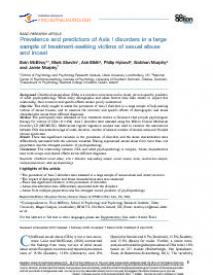Prevalence and predictors of Axis I disorders in a large sample of treatment-seeking victims of sexual abuse and incest
Background: Childhood sexual abuse (CSA) is a common occurrence and a robust, yet non-specific, predictor of adult psychopathology. While many demographic and abuse factors have been shown to impact this relationship, their common and specific effects remain poorly understood.
Objective: This study sought to assess the prevalence of Axis I disorders in a large sample of help-seeking victims of sexual trauma, and to examine the common and specific effects of demographic and abuse characteristics across these different diagnoses.
Method: The participants were attendees at four treatment centres in Denmark that provide psychological therapy for victims of CSA (N=434). Axis I disorders were assessed using the Millon Clinical Multiaxial Inventory-III (MCMI-III). Multivariate logistic regression analysis was used to examine the associations between CSA characteristics (age of onset, duration, number of abusers, number of abusive acts) and 10 adult clinical syndromes.
Results: There was significant variation in the prevalence of disorders and the abuse characteristics were differentially associated with the outcome variables. Having experienced sexual abuse from more than one perpetrator was the strongest predictor of psychopathology.
Conclusions: The relationship between CSA and adult psychopathology is complex. Abuse characteristics have both unique and shared effects across different diagnoses.
In: European journal of psychotraumatology, ISSN 2000-8066 | 7 | 1 | april | 30686
http://dx.doi.org/10.3402/ejpt.v7.30686


